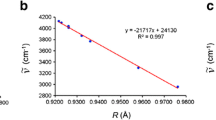Abstract
The energy hypersurface of the system NH3 · H2O is investigated for a number of different internuclear geometries. In the minimum energy structure involving a linear hydrogen bond, NH3 acts as proton acceptor. The binding energy of the system is calculated to be 6.28 kcal/mole and the bond distance d(NO) to be 3.07 Å. The potential energy curve of the inversion of the hydrogenbonded NH3 is computed and discussed.
Zusammenfassung
Die Energiehyperflächen des NH3 · H2O-Systems wurden für eine Anzahl von verschiedenen geometrischen Anordnungen untersucht. Im Falle der Struktur minimaler Energie wird eine lineare Wasserstoffbindung gebildet, NH3 wirkt als Protonakzeptor. Die Berechnungen ergeben eine Bindungsenergie des Systems von 6,28 kcal/Mol und einen NO-Abstand von 3,07 Å. Außerdem wurde die Potentialkurve für die Inversion des über eine Wasserstoffbrücke gebundenen NH3 berechnet und diskutiert.
Similar content being viewed by others
References
Kollman,P.A., Allen,L.C.: J. Amer. chem. Soc. 92, 753 (1970).
Kollman,P.A., Allen,L.C.: J. Amer. chem. Soc. 93, 4991 (1971).
Swalen,J.D., Ibers,J.A.: J. chem. Physics 36, 1914 (1962) (see this work for further references).
Rauk,A., Allen,L.C., Clementi,E.: J. chem. Physics 52 4133 (1970) (see this work for further references).
Roothaan,C.C.J.: Rev. mod. Physics 23, 69 (1951).
Veillard,A.: IBMOL/VERSION IV, Special IBM Technical Rept. San José, California: 1968.
Preuss,H., Diercksen,G.: Int. J. quant. Chemistry 1, 605 (1967).
Diercksen,G.H.F., Kraemer,W.P.: MUNICH, Molecular Program System, Reference Manual, Special Technical Report. Max-Planck-Institut für Physik und Astrophysik, München (to be published).
Salez,G., Veillard,A.: Theoret. chim. Acta (Berl.) 11, 441 (1968).
Neuman,D., Moskowitz,J.W.: J. chem. Physics 49, 2056 (1968).
Diercksen,G.H.F.: Chem. Physics Letters 4, 373 (1969); Theoret. chim. Acta (Berl.) 21, 335 (1971).
Diercksen,G.H.F. et al.: unpublished results.
Diercksen, G.H.F, Kraemer, W.P.: Chem. Physics Letters 6, 419 (1970).
For a definition of the basis set notation used here, see: Moskowitz,J.W., Harrison,M.C.: J. chem. Physics 43, 3550 (1965).
Author information
Authors and Affiliations
Additional information
It is a pleasure to thank our technical staff for the careful preparation of the input for the programs and for its skillful assistance in running the computer.
Rights and permissions
About this article
Cite this article
Diercksen, G.H.F., Kraemer, W.P. & von Niessen, W. SCF MO LCGO Studies on hydrogen bonding: The system NH3 · H2O. Theoret. Chim. Acta 28, 67–74 (1972). https://doi.org/10.1007/BF00528873
Received:
Issue Date:
DOI: https://doi.org/10.1007/BF00528873




